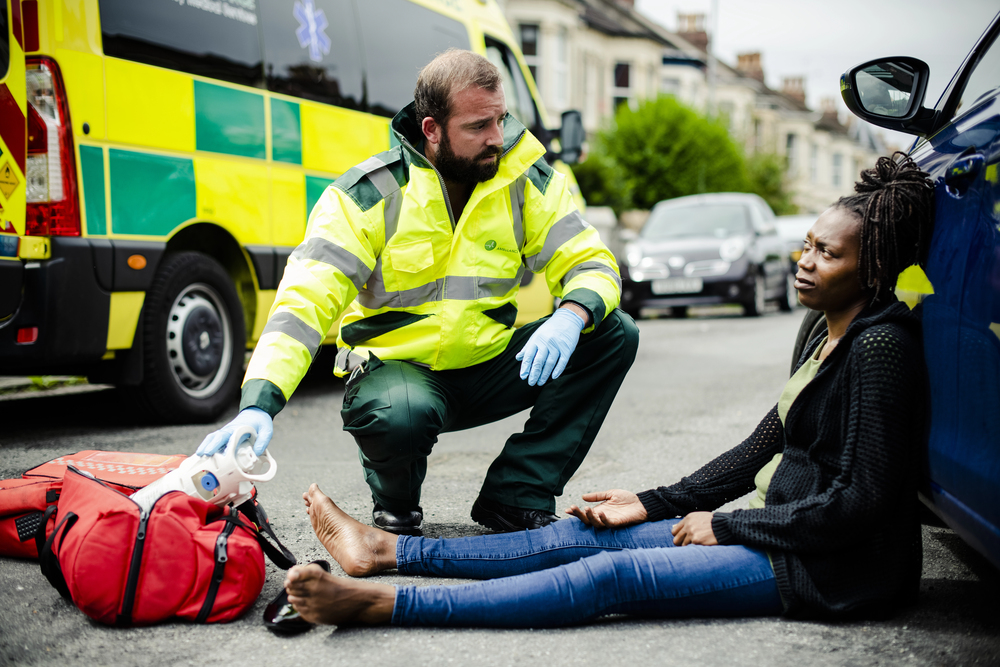Emergency Medical Responder (EMR) certification is your gateway to a crucial role in emergency healthcare. As an EMR, you become part of the first line of defense in critical situations, equipped with the skills to save lives when minutes matter most.
EMRs provide essential medical care during those crucial moments between an emergency and the arrival of advanced medical personnel. Your responsibilities include:
- Performing initial patient assessments
- Delivering basic life support
- Managing bleeding and shock
- Stabilizing fractures and injuries
- Assisting higher-level emergency personnel
The demand for qualified EMRs continues to grow across various sectors:
- Healthcare facilities
- Fire departments
- Law enforcement agencies
- Industrial safety teams
- Sports organizations
This guide will walk you through every aspect of obtaining your EMR certification – from educational requirements to training programs, costs, and career opportunities. You’ll discover the differences between online and in-person training options, understand certification maintenance requirements, and gain insights into the rewarding career paths available to certified EMRs.
Whether you’re starting your journey in emergency response or seeking to enhance your existing medical credentials, EMR certification opens doors to meaningful work where your actions directly impact people’s lives.
Understanding EMR Certification
EMR certification is your official recognition as a qualified Emergency Medical Responder. It validates your ability to provide essential life-saving care during critical situations and serves as proof that you’ve mastered the fundamental skills and knowledge required to assist in emergency medical situations.
Benefits of National Certification:
- Recognition across multiple states
- Enhanced career opportunities
- Standardized quality of care
- Professional credibility
- Access to continuing education resources
The National Registry of Emergency Medical Technicians (NREMT) is the main certification body for EMRs in the United States. This non-profit organization sets high standards for emergency medical service providers, ensuring consistent quality care throughout the country.
Requirements for NREMT Certification:
- Completion of a state-approved EMR course
- Passing the cognitive examination
- Successful performance in psychomotor skills testing
- Background check clearance
- Meeting age and education prerequisites
Your EMR certification through NREMT involves demonstrating proficiency in:
- Basic life support techniques
- Patient assessment methods
- Emergency scene management
- Medical equipment operation
- Crisis intervention strategies
The certification process usually takes 2-3 months, including course completion and examination periods. You can find EMR courses offered by:
- Community colleges
- Fire departments
- Healthcare facilities
- Emergency medical services agencies
- Accredited online platforms
The NREMT has a database of certified EMRs, allowing potential employers to quickly verify credentials. This system helps ensure that only qualified individuals provide emergency medical care, maintaining high standards across the emergency response field.
Your certification status remains active for two years, during which you’ll need to complete specific continuing education requirements to maintain your credentials. The NREMT provides regular updates on certification requirements and industry standards through their official website and professional network.
The Role and Responsibilities of an Emergency Medical Responder
Emergency Medical Responders (EMRs) are the first responders in critical situations, providing immediate life-saving care when every second matters. Their quick response and specialized training can make the difference between life and death before advanced medical help arrives.
Core Responsibilities of EMRs:
- Performing initial patient assessments
- Administering basic life support and CPR
- Managing bleeding and shock
- Stabilizing fractures and spinal injuries
- Assisting in childbirth emergencies
- Providing care for respiratory emergencies
- Managing cardiac arrest situations
EMRs work within a structured EMS system, but their role is different from other emergency personnel. While EMTs and Paramedics can perform advanced medical procedures and transport patients, EMRs focus on immediate care at the scene of an emergency.
Key Distinctions Between Emergency Personnel:
- EMRs: Provide basic life support, scene assessment, patient stabilization
- EMTs: Offer intermediate care, patient transport, medication administration
- Paramedics: Deliver advanced life support, complex medical procedures, extensive patient care
The EMS system depends on EMRs as important team members. They fill the critical gap between the incident and the arrival of advanced medical support. EMRs often work in different environments:
- Fire departments
- Police departments
- Industrial facilities
- Sports venues
- Schools
- Remote locations
- Community events
As an EMR, you need to think quickly, adapt to different situations, and communicate effectively. You’ll have to make fast decisions under pressure while working with other emergency responders. The emergency medical responder course, whether taken in person or through an online program, teaches you these essential skills and prepares you for real-life emergency situations.
The Path to Becoming an Emergency Medical Responder
Starting your journey as an Emergency Medical Responder requires meeting specific educational prerequisites and developing essential competencies. Here’s what you need to know about the path to EMR certification:
Basic Educational Requirements
- High school diploma or equivalent
- Must be at least 18 years old
- Valid driver’s license
- Clean criminal background check
- Current CPR certification
Essential Skills and Competencies
Physical Requirements
- Ability to lift and carry up to 50 pounds
- Physical stamina for extended periods of activity
- Manual dexterity for medical procedures
- Clear speech and hearing capabilities
- Visual acuity to assess patients and read medical instruments
Personal Attributes
- Strong decision-making abilities under pressure
- Excellent communication skills
- Emotional stability
- Team collaboration capabilities
- Cultural sensitivity
Core Knowledge Areas
- Human anatomy and physiology
- Basic life support techniques
- Patient assessment methods
- Medical terminology
- Scene safety protocols
- Emergency vehicle operations
- Documentation procedures
Required Certifications
- Basic Life Support (BLS)
- Bloodborne Pathogens Training
- Hazardous Materials Awareness
- Traffic Incident Management
- National Incident Management System (NIMS)
The path to becoming an EMR demands dedication to learning and skill development. Your training will combine classroom instruction with hands-on practice sessions. Many EMR candidates come from diverse backgrounds – some transition from other healthcare roles, while others start fresh in the emergency medical field.
Local regulations might require additional prerequisites or certifications. Check with your state’s EMS office for specific requirements in your area. Some employers also mandate extra qualifications beyond the basic EMR certification.
If you’re uncertain about whether this career is the right fit for you, consider exploring different career paths before making a commitment.
Emergency Medical Response Training Programs and Courses
EMR training programs come in various formats to accommodate different learning styles and schedules. Traditional in-person programs offer hands-on experience in controlled environments, while online courses provide flexibility for busy professionals.
Standard Course Components:
- Basic life support techniques
- Patient assessment methodologies
- Trauma care procedures
- Medical emergency response protocols
- Scene safety and personal protection
- Communication with emergency services
- Documentation and reporting
In-Person Training Programs
These programs typically span 56-60 hours of instruction, combining classroom lectures with practical exercises. Students work directly with experienced instructors and practice scenarios using medical equipment and mannequins.
Online EMR Training Options
Digital learning platforms offer:
- Self-paced video lectures
- Interactive learning modules
- Virtual simulations
- Remote instructor support
- Online assessments
- Flexible scheduling options
The theoretical portion of EMR training covers essential medical knowledge:
- Human anatomy and physiology
- Medical terminology
- Emergency response protocols
- Legal and ethical considerations
Practical Skills Development
Both online and in-person programs include mandatory hands-on components:
- CPR and AED usage
- Bleeding control techniques
- Splinting and bandaging
- Patient moving and lifting
- Vital signs assessment
- Airway management
Program Duration and Structure
Most EMR courses follow a structured timeline:
- 40 hours of didactic instruction
- 16-20 hours of practical skills training
- Skills verification sessions
- Written examinations
- Clinical observations
Programs often incorporate real-world scenarios through case studies and simulated emergency situations. Students learn to handle various emergencies while maintaining professional composure under pressure.
Certification Process for Emergency Medical Responders
Obtaining your EMR certification involves a structured process through the National Registry of Emergency Medical Technicians (NREMT). Here’s what you need to know about the certification pathway:
Prerequisites for Certification
- Must be at least 16 years old
- Hold a current CPR-BLS certification
- Complete a state-approved EMR course
- Pass a criminal background check
- Submit proof of immunizations
NREMT Cognitive Exam
The computer-based test evaluates your knowledge across five key areas:
- Airway, respiration, and ventilation
- Cardiology and resuscitation
- Trauma assessment and management
- Medical emergencies
- EMS operations
The exam adapts to your performance, selecting questions based on your previous answers. You’ll face between 70-120 questions, with a time limit of 2 hours.
Psychomotor Examination
This hands-on skills assessment tests your practical abilities in:
- Patient assessment and management
- Bleeding control and shock management
- Upper airway management
- Cardiac arrest management
- Spinal immobilization
Application Process
- Create an account on NREMT.org
- Submit your application with required documentation
- Pay the certification fee
- Schedule your cognitive exam at a Pearson VUE testing center
- Complete the psychomotor exam at an approved testing site
State Requirements
Each state maintains specific requirements for EMR certification. You’ll need to:
- Submit state-specific documentation
- Pay additional licensing fees
- Complete any state-mandated background checks
- Meet local continuing education requirements
The certification process typically takes 2-4 weeks after completing your training program, depending on test scheduling availability and processing times.
Maintaining Your EMR Certification: Renewal and Recertification Process
Your EMR certification requires regular renewal to ensure you maintain up-to-date knowledge and skills in emergency medical response. The National Registry of Emergency Medical Technicians (NREMT) mandates recertification every two years.
Key Requirements for EMR Recertification:
- Complete 12 hours of continuing education
- Maintain current CPR certification
- Submit recertification application before expiration date
- Pay applicable renewal fees
Handling Lapsed Certifications
If your certification expires, you’ll need to follow specific steps for reinstatement:
- Within 30 days of expiration: Submit renewal application with late fee
- 30 days to 2 years lapsed: Complete additional continuing education hours
- Over 2 years lapsed: Retake both cognitive and psychomotor examinations
The recertification process includes specific topic requirements:
- Airway, breathing, and cardiology (3 hours)
- Medical emergencies (2 hours)
- Trauma (2 hours)
- Operations (1 hour)
- Flexible core requirements (4 hours)
State requirements might vary, so check your local EMS office for additional recertification mandates. Many employers offer in-house continuing education programs to help you maintain your certification status.
Online vs. In-Person Training Options for EMRs
EMR certification training now offers both online and traditional classroom options, each with distinct advantages for different learning styles and schedules.
Benefits of Online EMR Training:
- Flexible scheduling for self-paced learning
- Access to course materials 24/7
- Lower costs without commuting expenses
- Interactive digital simulations
- Ability to review materials multiple times
- Convenient for remote locations
Advantages of Traditional Classroom Training:
- Direct hands-on experience with equipment
- Real-time feedback from instructors
- Immediate clarification of questions
- Physical practice with mannequins
- Face-to-face interaction with peers
- Structured learning environment
Hybrid Programs
Many EMR certification programs now offer hybrid options, combining online coursework with in-person skill sessions. These programs blend digital learning for theoretical knowledge with practical hands-on training sessions.
Factors to Consider When Choosing Your Training Format
Your choice between online and in-person EMR training should consider:
- Your learning style preferences
- Time availability
- Geographic location
- Budget constraints
- Technology comfort level
- Need for hands-on practice
State requirements vary regarding the acceptance of online EMR certification programs. Check your local EMS authority’s regulations before enrolling in any program to ensure compliance with certification standards.
Costs Associated with EMR Certification Programs
The financial investment for EMR certification varies based on location, program type, and additional requirements. Here’s a detailed breakdown of typical costs:
1. Program Tuition
- Basic EMR courses: $200-$500
- Comprehensive programs: $800-$1,200
- Refresher courses: $150-$300
2. Required Materials and Equipment
- Textbooks: $50-$100
- CPR mask and personal protective equipment: $30-$75
- Uniform requirements: $50-$150
3. Certification Fees
- NREMT cognitive exam: $75
- State certification fees: $25-$75
- Background check: $50-$100
4. Additional Expenses
- Health screenings: $50-$150
- Immunizations: $100-$300
- Professional liability insurance: $100-$200 annually
Many programs offer payment plans or financial assistance options to help manage these costs. Some employers reimburse certification expenses for their staff, making it worthwhile to check with your current workplace about potential coverage.
Military veterans can often use their GI Bill benefits to cover EMR training costs. Local fire departments and volunteer organizations sometimes sponsor EMR candidates, reducing or eliminating out-of-pocket expenses.
Consider these costs as an investment in your professional development – EMR certification opens doors to career advancement and higher earning potential in emergency services.
Conclusion: Pursuing a Rewarding Career in Emergency Response Through EMR Certification
EMR certification opens doors to a meaningful career where you can make a real difference in people’s lives. The path to becoming a certified Emergency Medical Responder equips you with essential skills that serve as a foundation for advanced medical roles and personal growth.
Your EMR certification demonstrates:
- Professional Competence: Validated skills in emergency response and patient care
- Commitment to Service: Dedication to helping others in critical moments
- Career Advancement: Potential stepping stone to EMT, Paramedic, or other healthcare roles
The impact of certified EMRs extends beyond individual emergencies – you become part of a vital network of healthcare professionals who strengthen community safety and emergency preparedness.
Starting your EMR certification journey requires dedication, but the rewards are significant:
- Immediate impact on patient outcomes
- Flexible career opportunities
- Personal satisfaction from helping others
- Continuous learning and skill development
Your EMR certification isn’t just a credential – it’s your gateway to a dynamic career in emergency response. The skills you gain, the lives you touch, and the professional growth you experience make EMR certification a worthwhile investment in your future.
FAQs (Frequently Asked Questions)
What is EMR certification?
EMR certification, or Emergency Medical Responder certification, is a credential that verifies an individual’s training and competency in providing basic emergency medical care. It is essential for those looking to work in emergency response roles.
What are the responsibilities of an Emergency Medical Responder?
Emergency Medical Responders (EMRs) are first responders who provide immediate care to patients in emergencies. Their responsibilities include assessing patients, providing basic life support, and ensuring safe transportation to medical facilities.
How can I become certified as an Emergency Medical Responder?
To become certified as an Emergency Medical Responder, individuals must complete an approved EMR training program, pass the required examinations, and meet any local or national certification requirements.
What types of training programs are available for EMRs?
EMR training programs can be offered in various formats, including in-person classes and online courses. These programs typically cover essential skills and knowledge necessary for effective emergency response.
What is the process for renewing my EMR certification?
To maintain EMR certification, individuals must participate in continuing education and may need to complete recertification exams. Procedures vary based on local regulations and the certifying body.
What costs should I expect when pursuing EMR certification?
Costs associated with obtaining EMR certification can include tuition fees for courses, materials needed for training, and examination fees. It’s important to review all potential expenses before enrolling in a program.



